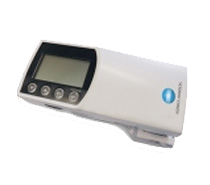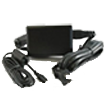FD-7 Spectrodensitometer (Discontinued)
Support FD-7 will be provided until 31 March 2031
Many industries that rely heavily on graphics have been shifting to digital methods during recent time. Controlling the quality of printed materials numerically is easier and more efficient than visual evaluation. However, printed products are made to be seen by the human eye. To that end, measurement results must resemble results that would be obtained through visual evaluation.
A common obstacle during print quality assessment is the paper that is used. Often printing paper contains fluorescent whitening agents (FWA) to make the paper appear brighter. The addition of these agents has an immense impact on the color of printed material, especially when the illuminate D50*1 is used for viewing. In order to lessen measurement result inconsistencies due to paper fluorescence, ISO 13655-2009*2 defined measurement condition M1 as having illumination corresponding to CIE Illuminant D50. However, conventional handheld spectrodensitometers have a hard time measuring this effect.
Konica Minolta has raised the bar yet again by creating VFS (virtual fluorescence standard) technology. The FD series allows users to evaluate color while controlling for paper fluorescence. The FD series accomplishes this under illuminant D50, the standard light source measure currently used by the printing industry for color evaluation. These are the first tools to ever be manufactured that allow for measurement results that correspond with ISO 13655 Measurement Condition M1.
*1 A CIE defined artificial light source consisting of a spectral distribution that simulates daylight. This is commonly used for color measurement.
*2 ISO 13655-2009: Graphic technology Colorimetric computation and spectral measurement for graphic arts images.
Precise measurement, even when substrates include fluorescent whitening agents
- Color control and density by printers
- Measurement of fluorescence in R & D of paper manufacturers and printing machinery manufacturers
- Measurements of printed color patches
- Ink CCM systems input sensor
Features
- For Measuring Color and Density
- Uniquely corresponds to Measurement Condition M1 of ISO 13655
- The first M1 type in the world
- Konica Minolta’s original VFS (Virtual Fluorescence Standard) technology allows for L*a*b* measurements that correspond to ISO 13655 Measurement Condition M1 (CIE Illuminant D50).
- Additionally, color measurements corresponding to ISO 13655 Measurement Conditions M0 (CIE Illuminant A) and M2 (illumination with UV-cut filter) can also be taken easily and quickly.
- Industry’s very first automatic wavelength compensation function
- Wavelength compensation is performed simultaneously with white calibration with no additional work required.
- Until now, it was only possible for wavelength compensation to be carried out as one part of manufacturer servicing. This task is now performed during white calibration. This helps to maintain the highest measurement reliability values.
- Enables color measurements that correspond very closely to visual evaluation.
- Conventional instruments that measure materials printed on substrates containing fluorescent whitening agents (FWA) illustrate large differences between the results of measurements and visual evaluation. With the new FD-7/FD-5, measurement results correspond very closely to visual evaluation results. This includes but is not limited to the effects of any FWA in the paper.
- Simple operation
- Measurements of density, dot gain, dot area ratio, illumination, and color are simple.
- User-friendly instructions on the LCD screen guide so that anyone can take measurements easily
- World’ s lightest*1
- The main body weighs only about 350g. With the target mask attached it only weighs about 430g. This is lighter than any previous spectrodensitometer ever manufactured. The low weight of this instrument reduces the load on the users arm during work, which improves measurement accuracy over time.
- *1 Display-equipped spectrodensitometer. As of November 1, 2010
- Worry-free after-sales service
- Worldwide service centers provide quick and helpful technical support when needed.
- A far-reaching service network exists to ensure that your instrument is always functioning properly.
- Printing Color Management Software BasICColor catch all (Optional accessory)
- Easily customizable screen with data list view, 3D graph, pass/fail screen, etc.
- Compatible with various test charts (MediaWedge, ECI2002, IT8.7/3, etc.)
Specifications
| Model | FD-7 |
|---|---|
| Illumination/viewing system | 45°a: 0° (annular illumination) *1> Conforms to CIE No. 15, ISO 7724/1, DIN 5033 Teil 7, ASTM E 1164, and JIS Z 8722 Condition a for reflectance measurements |
| Spectral separation device | Concave grating |
| Wavelength range | Spectral reflectance: 360 nm to 740 nm |
| Wavelength pitch | 10 nm |
| Half bandwitdh | Approx. 10 nm |
| Measurement area | Φ3.5 mm |
| Light source | LED |
| Measurement range | Density: 0.0D to 2.5D; Reflectance: 0 to 150% |
| Short-term repeatability | Density: Σ 0.01D Colorimetric: Within Σ ΔE00 0.05 (When white plate is measured 30 times at 10-second intervals after white calibration has been performed) |
| Inter-instrument agreement | Within ΔE00 0.3 (Average of 12 BCRA Series II color tiles compared to values measured with a master body under Konica Minolta standard conditions) |
| Measurement time | Approx. 1.4 s (single-point reflectance measurement) |
| Measurement conditions | Corresponding to ISO 13655 Measurement Conditions M0 (CIE Illuminant A), M1 (CIE Illuminant D50), and M2 (illumination with UV-cut filter); User-defined illuminant |
| Illuminants | A, C, D50, ID50, D65, ID65, F2, F6, F7, F8, F9, F10, F11, F12, User-defined illuminant |
| Observers | 2°Standard Observer, 10 deg Standard Observer |
| Density | ISO Status T, ISO Status E, ISO Status A; DIN 16536 |
| Display language | English, French, German, Spanish, Japanese, Chinese (Simplified) |
| Interface | USB 2.0 |
| Output data*2 | Displayed values; Spectral reflectance data (FD-7 only) ; Spectral irradiance data (FD-7 only) |
| Power | Rechargeable internal lithium-ion battery (Number of measurements per charge: Approx. 2,000 when new); AC adapter; USB power bus |
| Dimensions (W x D x H) |
70 x 165 x 83 mm (Body only); 90 x 172 x 84 mm (With target mask attached) |
| Weight | Approx. 350 g (Body only); Approx. 430 g (With target mask attached) |
| Operating temperature/humidity range | 10 to 35° C, 30 to 85% relative humidity with no condensation |
| Storage temperature/ humidity range | 0 to 45°C, 0 to 85% relative humidity with no condensation |
| Standard Accessories | White Calibration Plate, Target Mask, Protection Glass, AC Adapter, USB Cable, Soft Case, Polarization Filter, Data Management Software FD-S1w, Illuminance Adapter (FD-7 only), Ruler (FD-7 only) |
| Optional Accessories | Color Management Software basICColor catch all, XY Automatic Color Measurement Stage Color Scout A3+, Color Management Software SpectraMagic NX2 |
|
Specifications are subject to change without notice. |
|


